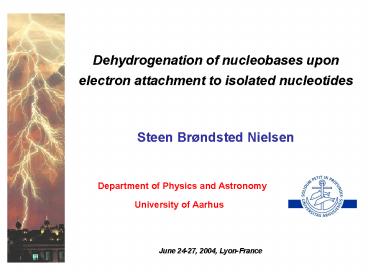Dehydrogenation of nucleobases upon electron attachment to isolated nucleotides - PowerPoint PPT Presentation
Title:
Dehydrogenation of nucleobases upon electron attachment to isolated nucleotides
Description:
Steen Br ndsted Nielsen. Department of Physics and Astronomy. University of Aarhus ... Direct absorption of light by the nucleobases followed by physical and ... – PowerPoint PPT presentation
Number of Views:76
Avg rating:3.0/5.0
Title: Dehydrogenation of nucleobases upon electron attachment to isolated nucleotides
1
Dehydrogenation of nucleobases upon electron
attachment to isolated nucleotides Steen
Brøndsted Nielsen Department of Physics
and Astronomy University of Aarhus
June 24-27, 2004, Lyon-France
2
DNA DAMAGE
3
HOW DOES UV RADIATION CAUSE GENETIC DAMAGE ?
Modification of nucleobases may lead to loss of
base-pairing specificity
- Direct absorption of light by the nucleobases
followed by physical and chemical reactions - and / or
- 2) Ionisation of water (H2O ? H2O? e-)
followed by electron attachment to nucleobases
4
OUR APPROACH
Elucidate the processes at the single-molecule
level. Isolated damage to nucleotides, the basic
building blocks of DNA and RNA, upon electron
attachment.
5
TOOLBOX
ELECTROSPRAY IONISATION MASS SPECTROMETRY ACCE
LERATOR INSTRUMENT ION STORAGE RING
ELISA LASERS QUANTUM CHEMICAL CALCULATIONS
6
ELECTROSPRAY IONISATION
droplets
BARE IONS
7
ELECTROSPRAY ION SOURCE
Tube lens
Octapole
Skimmer
Lenses
Acceleration tube
ESI needle 4kV
10-6 mbar
10-3 mbar
10-5 mbar
1 mbar
Heated capillary
22-pole ion trap
8
GAS-PHASE EXPERIMENTS ON NUCLEOTIDE ANIONS
PROBLEM Attachment of an electron to a negative
ion is unlikely because of the repulsion between
the two negative charges. SOLUTION High-energy
collisions with sodium electron transfer from
Na to the ion.
Compare the violent reaction of sodium with
water !
Nielsen et al., J. Am. Chem. Soc. 125, 9592-9593
(2003). Liu et al., Chem. Phys. Chem. 4,
1341-1344 (2003).
9
ACCELERATOR INSTRUMENT
Na collision cell
R 2 m B 1.4 T
T500 K
Magnet
Electrostatic analyser
0 V
Channeltron detector
?50 kV
ESI source
10
COLLISION INTERACTION TIME FEW FEMTOSECONDS
Nucleotide anion
-
105 m/s
1 nm
Na
The electron transfer process is nearly vertical.
11
Electron attachment to AMP anions
Ne
Na
m/q 346
Liu et al., Chem. Phys. Chem. 4, 1341-1344 (2003).
12
High-energy collisions between dAMP anions and Na
and Ne
dAMP2-
dAMP-
fragment ions
m/q 330
13
Spectrum obtained after collisions between
AMP-(H2O)13 and Na
AMP-(H2O)13
AMP2-
AMP2-(H2O)9
AMP-
14
Electron transfer from Na to dinucleotide anions
dianion
dG2
nucleobase
dT2
sugar
-
phosphate
nucleobase
dC2
sugar
dA2
15
IS THE NUCLEOTIDE DIANION INTACT ?
H loss is observed upon electron attachment to
nucleobases in vacuo. C. Desfrancois, H.
Abdoul-Carime, and J. P. Schermann, J. Chem.
Phys. 104, 7792 (1996). S. Gohlke, H.
Abdoul-Carime, and E. Illenberger, Chem. Phys.
Lett. 380, 595 (2003). G. Hanel, B. Gstir, S.
Denifl, P. Scheier, M. Probst, B. Farizon, M.
Farizon, E. Illenberger, and T. D. Märk, Phys.
Rev. Lett. 90, 188104 (2003). H. Abdoul-Carime,
S. Gohlke, and E. Illenberger, Phys. Rev. Lett.
92, 168103 (2004). H loss is observed upon
electron attachment to deoxyribose in vacuo. S.
Ptasinska, S. Denifl, P. Scheier, and T. D. Märk,
J. Chem. Phys. 18, 8505 (2004).
16
AMP dissolved in CD3OD Selection of
deuterium-labelled ions for collision experiments
Intact dianion
- H
- D
of D in AMP-
0
1
2
3
Exchangeable hydrogens
Liu et al., J. Chem. Phys., issued for Sept. 1
(2004).
17
WHAT IS THE ORIGIN OF THE HYDROGEN ? -POH
phosphoric acid group -OH sugar -NH2
nucleobase -CH sugar or nucleobase
18
Electron attachment to nucleotides dehydrogenatio
n at nitrogen sites
Thymine Uracil
Adenine Cytosine Guanine
1 2
3
19
Cross section for formation of dehydrogenated
dianion
20
Dissociative electron attachment to deuterated
thymine
- H-loss from N
- No D-loss from C
H. Abdoul-Carime, S. Gohlke, and E. Illenberger,
Phys. Rev. Lett. 92, 168103 (2004).
21
THE DNA DOUBLE HELIX
22
Watson-Crick base pairs Base mispairing
Biological relevance?
23
WHAT IS THE LIFETIME OF THE DIANION ?
24
ELectrostatic Ion Storage Ring Aarhus (ELISA)
Channeltron
Ion bunch
Magnet
Sodium
Injection
Micro-channel plate detector
1 m
Accelerator with electrospray ion source
S.P. Møller, NIM A 394, 281 (1997). J.U.
Andersen, J.S. Forster, P. Hvelplund, T.J.D.
Jørgensen, S.P Møller, S. Brøndsted Nielsen, U.V.
Pedersen, S. Tomita, and H. Wahlgreen, Rev. Sci.
Instrum. 73, 1284-1287 (2002).
25
(No Transcript)
26
Electron autodetachment from the AMP dianion
Liu et al., J. Chem. Phys., issued for Sept. 1
(2004).
27
Long-lived component ? Dump of a remaining beam
in the micro-channel plate detector after 34 ms
of storage time.
Channeltron
Ion bunch
Magnet
Sodium
Injection
Micro-channel plate detector
1 m
Accelerator with electrospray ion source
28
Dump of beam in the detector after 34 ms of
storage time
AMP2- (m/q 172.5)
13C-AMP2- (m/q 173)
29
CONCLUSIONS
- Electron transfer to nucleotide anions occurs
in - collisions with sodium vapour.
- Electron attachment leads to dehydrogenation of
- the nucleobase nitrogens.
- The dehydrogenated dianion is longlived.
Other fragmentation channels than H-loss upon
electron attachment ?
30
ACKNOWLEDGEMENTS
University of Aarhus Preben Hvelplund Jens
Ulrik Andersen Shigeo Tomita Bo Liu Jimmy
Rangama Leopold-Franzens Universität
Innsbruck Paul Scheier Gabriel Hasan
FUNDING The Danish Natural Science Research
Council Aarhus Center for Atomic Physics (ACAP)
31
Collisional electron transfer to peptide
dications SELECTIVE FRAGMENTATION CHANNELS
32
FRAGMENTATION SPECTRA
M 2H2
M 2H
Substance P
Na
Amino acid sequence RPKPQQFFGLM
M 2H2
Ne
33
Amino acid sequence RPKPQQFFGLM
M 2H2
M 2H
Hvelplund et al., Int. J. Mass Spectrom. 225,
83-87 (2003).

